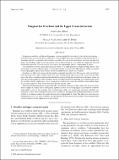Marginal sea overflows and the upper ocean interaction
Author(s)
Kida, Shinichiro; Yang, Jiayan; Price, James F.
DownloadKida-2009-Marginal sea overflo.pdf (1.822Mb)
PUBLISHER_POLICY
Publisher Policy
Article is made available in accordance with the publisher's policy and may be subject to US copyright law. Please refer to the publisher's site for terms of use.
Terms of use
Metadata
Show full item recordAbstract
Marginal sea overflows and the overlying upper ocean are coupled in the vertical by two distinct mechanisms— by an interfacial mass flux from the upper ocean to the overflow layer that accompanies entrainment and by a divergent eddy flux associated with baroclinic instability. Because both mechanisms tend to be localized in space, the resulting upper ocean circulation can be characterized as a b plume for which the relevant background potential vorticity is set by the slope of the topography, that is, a topographic b plume.
The entrainment-driven topographic b plume consists of a single gyre that is aligned along isobaths. Thecirculation is cyclonic within the upper ocean (water columns are stretched). The transport within one branch of the topographic b plume may exceed the entrainment flux by a factor of 2 or more. Overflows are likely to be baroclinically unstable, especially near the strait. This creates eddy variability in both the upper ocean and overflow layers and a flux of momentum and energy in the vertical. In the time mean, the eddies accompanying baroclinic instability set up a double-gyre circulation in the upper ocean, an eddy-driven topographic b plume. In regions where baroclinic instability is growing, the momentumflux from the overflow into the upper ocean acts as a drag on the overflow and causes the overflow to descend the slope at a steeper angle than what would arise from bottom friction alone.
Numerical model experiments suggest that the Faroe Bank Channel overflow should be the most prominent
example of an eddy-driven topographic b plume and that the resulting upper-layer transport should be
comparable to that of the overflow. The overflow-layer eddies that accompany baroclinic instability are analogous to those observed in moored array data. In contrast, the upper layer of the Mediterranean overflow is likely to be dominated more by an entrainment-driven topographic b plume. The difference arises because entrainment occurs at a much shallower location for the Mediterranean case and the background potential vorticity gradient of the upper ocean is much larger.
Date issued
2009-02Department
Joint Program in Oceanography/Applied Ocean Science and Engineering; Woods Hole Oceanographic InstitutionJournal
Journal of Physical Oceanography
Publisher
American Meteorological Society
Citation
Kida, Shinichiro, Jiayan Yang, and James F. Price. “Marginal Sea Overflows and the Upper Ocean Interaction.” J. Phys. Oceanogr. 39.2 (2011) : 387-403. © 2010 American Meteorological Society.
Version: Final published version
ISSN
0022-3670
1520-0485